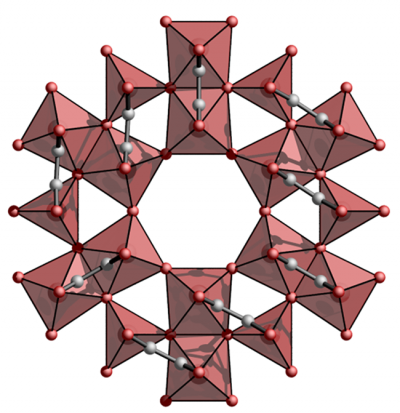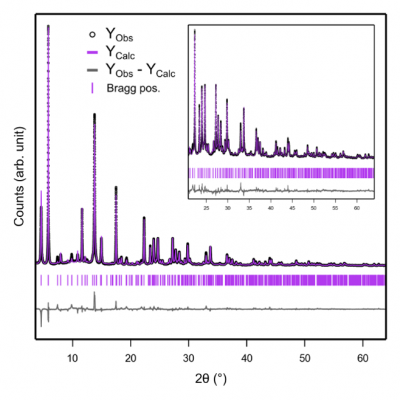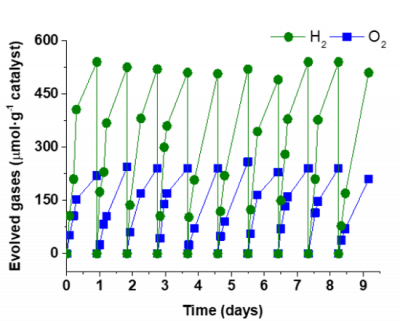The generation of green fuels (e.g. H2) is nowadays a very important research topic associated to the growing energy demand. Photocatalysis appears as a challenging path to produce H2 just from water.
An international collaboration between scientists from Spain and Sweden presents a new highly robust photocatalyst based on a titanium squarate metal organic framework* (MOF) that achieves the highest H2 production compared with other MOFs. This new material, which 3D structure was unveiled notably using CRISTAL beamline at SOLEIL, opens the gates to the production of solar fuels using hybrid material photocatalysts.
* MOFs are hybrid materials, combining an organic ligand and a metal ion, which gives them original properties.
The synthesis of novel metal-organic frameworks (MOFs) based on Ti(IV) is a very challenging and attractive topic, as a consequence of the interesting properties of Ti (e.g. low toxicity, low price, photocatalytic activity). However, the number of reported Ti-MOF structures is still scarce (< 30, from literature) due to the high tendancy of the Ti4+ cations to form oxides, preferentially TiO2.
In this work, the synthesis and full characterization of a novel porous MOF (branded as IEF-11, see fig. 1) based on the photoactive titanium and squarate ligand is reported.

Figure 1: IEF-11 crystalline structure
This nanomaterial (85 ± 30 nm, n** = 100) was prepared by heating a mixture of precursors dispersed in a solvent in a closed reactor using a high through-put method (that allows optimizing the synthetic conditions while minimizing time and resources). Due to its nanometric nature, the structural elucidation of IEF-11 was not possible by conventional methods (e.g. single-crystal X-ray diffraction-SCXRD, powder X-ray diffraction-PXRD using classical R-ray source). Therefore, its structure was unveiled by combining the non-conventional and advanced techniques of three-dimensional electron diffraction (3DED; Dep. Materials and Environmental Chemistry, Stockholm University, Sweden) to solve the 3D structure and synchrotron PXRD (CRISTAL beamline, SOLEIL; Fig. 2) to refine it.

Figure 2: Rietveld refinement of the IEF-11 crystalline structure using synchrotron data
IEF-11 structure was constructed by layers of interconnected TiO5 and TiO6 polyhedra as secondary building unit (SBU; Fig. 1), stacked overlapping and linked by the squarate moieties creating 1D porous channels. IEF-11 showed an outstanding thermal (up to 300 ºC) and chemical stability (e.g. pH, industrial organic solvents) and a light absorption in the visible range. The evaluation of IEF-11 optoelectronic properties supported its suitability as photocatalyst for both the hydrogen evolution (HER: H2O + electron donor + hν → H2) and the overall water splitting reactions (OWSR: H2O + hν → H2 +O2; Fig 3; collaboration with the Chemical Dep. at Polytechnical University of Valencia and Instituto de Tecnología Química, Spain). The performance of IEF-11 in the HER was in the average of other MOF-based photocatalysts, obtaining a H2 production of 1391 µmol H2·g-1catalyst in 5 h. For the OWSR, IEF-11 appeared as the best performing MOF, with a production of 672 µmol H2·g-1catalyst in 22 h under simulated sunlight during more than 10 days, keeping intact its structure and chemical composition.

Figure 3: Gases evolution profile of the IEF-11 as photocatalyst in overall water splitting reaction during 10 days
As conclusion, a new highly robust and porous titanium(IV) squarate MOF was synthesized and characterized, exhibiting suitable properties to efficiently perform overall water splitting photocatalysis. Without any further modification, IEF-11 was able to produce H2 and O2 at rates among the highest ever reported. Further, IEF-11 photocatalyst remained stable for extended irradiation periods (10 days) without any significant loss of crystallinity and photocatalytic activity.
Considering the versatility of MOF design, IEF-11 could serve as a leading structure for developing a series of Ti-MOFs with response in the light-visible range by adjusting the Ti-O-Ti connectivity, ligand functionalization and post-synthetic modifications to obtain a new generation of efficient solar MOF photocatalysts.
** n is the number of particles measured to determine the particle size and its error
